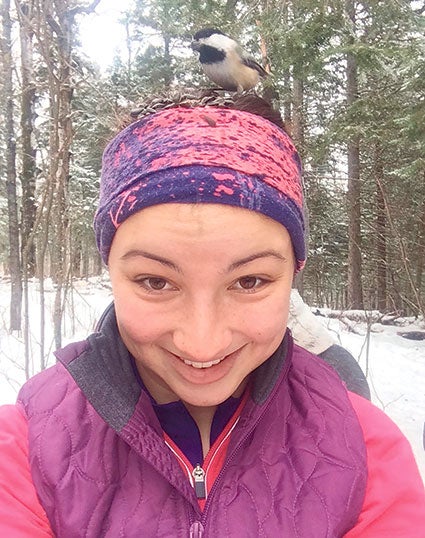How does one of the smallest birds survive Minnesota winters?
Published 5:42 am Tuesday, January 7, 2020
Editor’s note: This is the first printing of a new column from the Jay C. Hormel Nature Center’s teacher/naturalist Sydney Weisinger exploring the outdoors around us and will run the first Tuesday of every month
By Sydney Weisinger
Jay C. Hormel Nature Center teacher/naturalist
Black-capped chickadees may be one of the most easily recognizable birds both by their look and by their call: “chicka-dee-dee-dee.” However, did you know that chickadees are one of the smallest and hardiest birds that stay and face Minnesota winters head on?
Most people think about birds migrating south, moving to warmer locations, and living through the winter season in these areas. Have you ever considered how such a tiny bird like the chickadee manages to survive our harsh Minnesota winters?

Jay C. Hormel Nature Center teacher/naturalist Sydney Weisinger and her little chickadee friend. Photo provided
One of my favorite classes to teach was about birds in the winter, specifically chickadees because they have some great adaptations to survive the cold winter months. One of the chickadees’ adaptations is their memory. To demonstrate this to the students, we would take a handful of sunflower seeds and hide them outside before going on a birding hike, then we would have to come back two hours later and try to find all the seeds we hid. This activity opened the students’ eyes to how amazing chickadees memories are, because most of the students could not remember where they hid their seeds. Chickadees start to stash food in autumn to go back to on really cold and short days. Having extra stashes of food around is necessary for these birds since they are burning so much energy every day in order to keep their body temperature around 108 degrees Fahrenheit.
Of course, their half-inch coat of insulating feathers helps keep them warm. They fluff those feathers up at night to fill every inch of their roost cavities to keep out as much wind as possible. The most amazing adaptation is the fact that they have the ability to go into regulated hypothermia, which enables them to lower their body temperature about 12 to 15 degrees Fahrenheit. This allows them to conserve their fat storage and survive some of the coldest nights. Another great way to stay warm is to share a roost cavity and body heat with a fellow chickadee.
They flock together and hang out in the same place, forming a social group of 6-10 birds during the daytime in the winter. One could see these social groups that chickadees form around feeders; sometimes nuthatches and downy woodpeckers will join these social groups, which are called flocks. These flocks defend a territory of up to 20 acres and you can usually hear territory skirmishes surrounding the feeders. Listen for a “dee-dee” alarm sound when chickadees are defending their territory. There are many different communication sounds going on at your feeders, so get out there and listen!
Upcoming Events at Hormel Nature Center
• Jan. 20: Closed for Martin Luther King Day
• Jan. 25: 8:30 a.m. Cross-Country Ski Lessons – Free but must call the Nature Center to sign up, space is limited.
• Jan. 26: 1:30 p.m. Fiends Annual Meeting with a program by Dan Block. Free but must call the Nature Center to sign up



